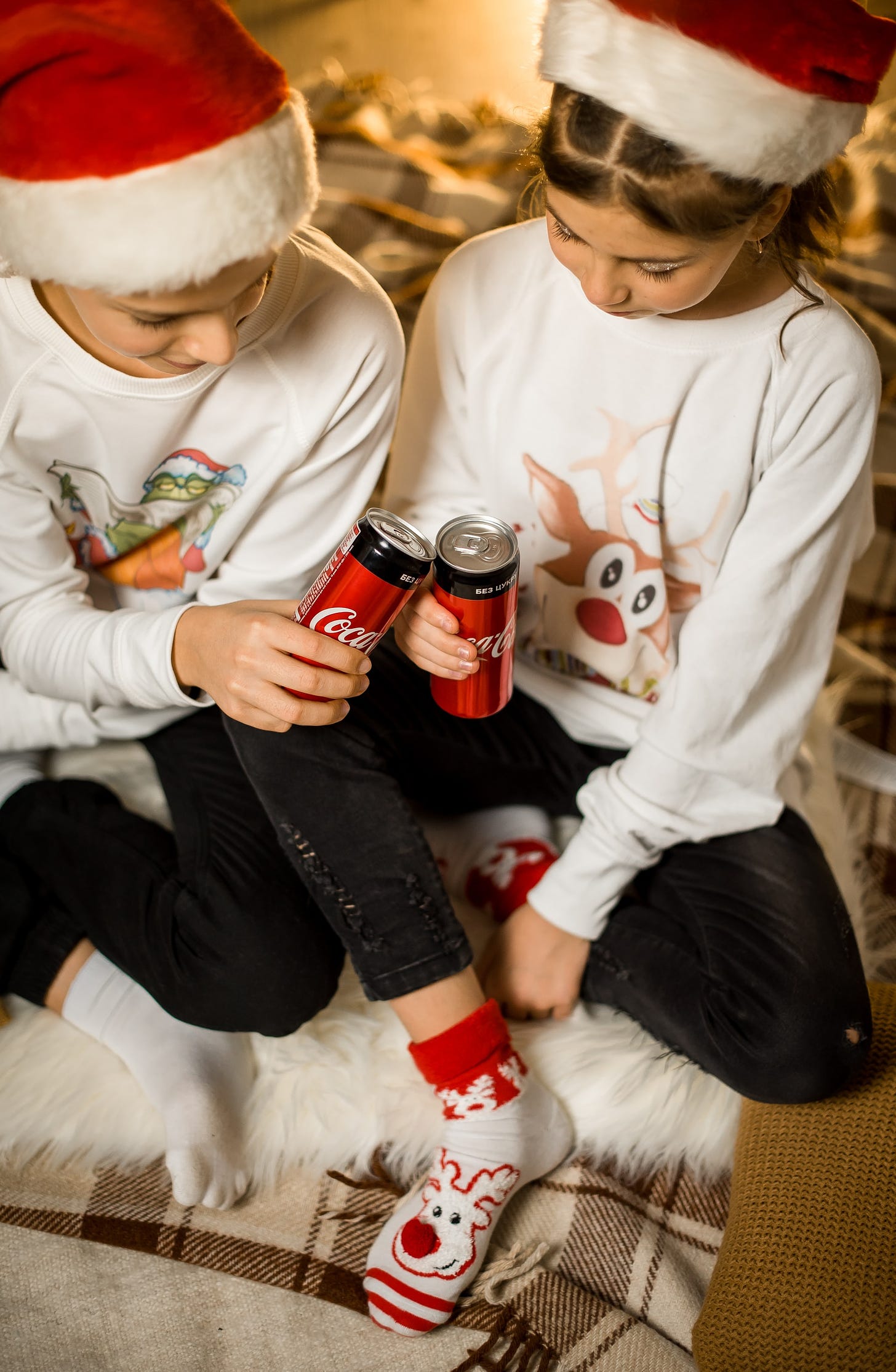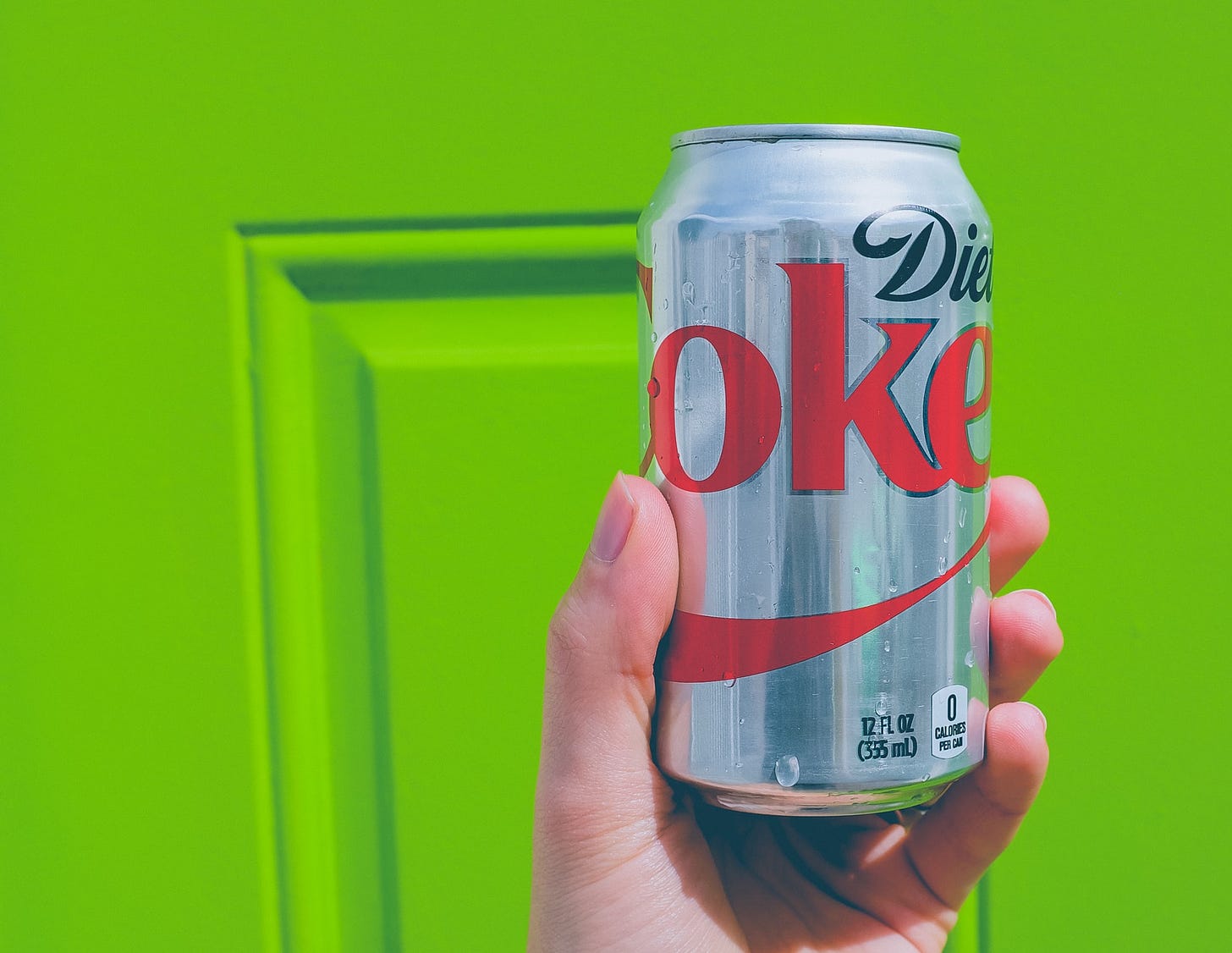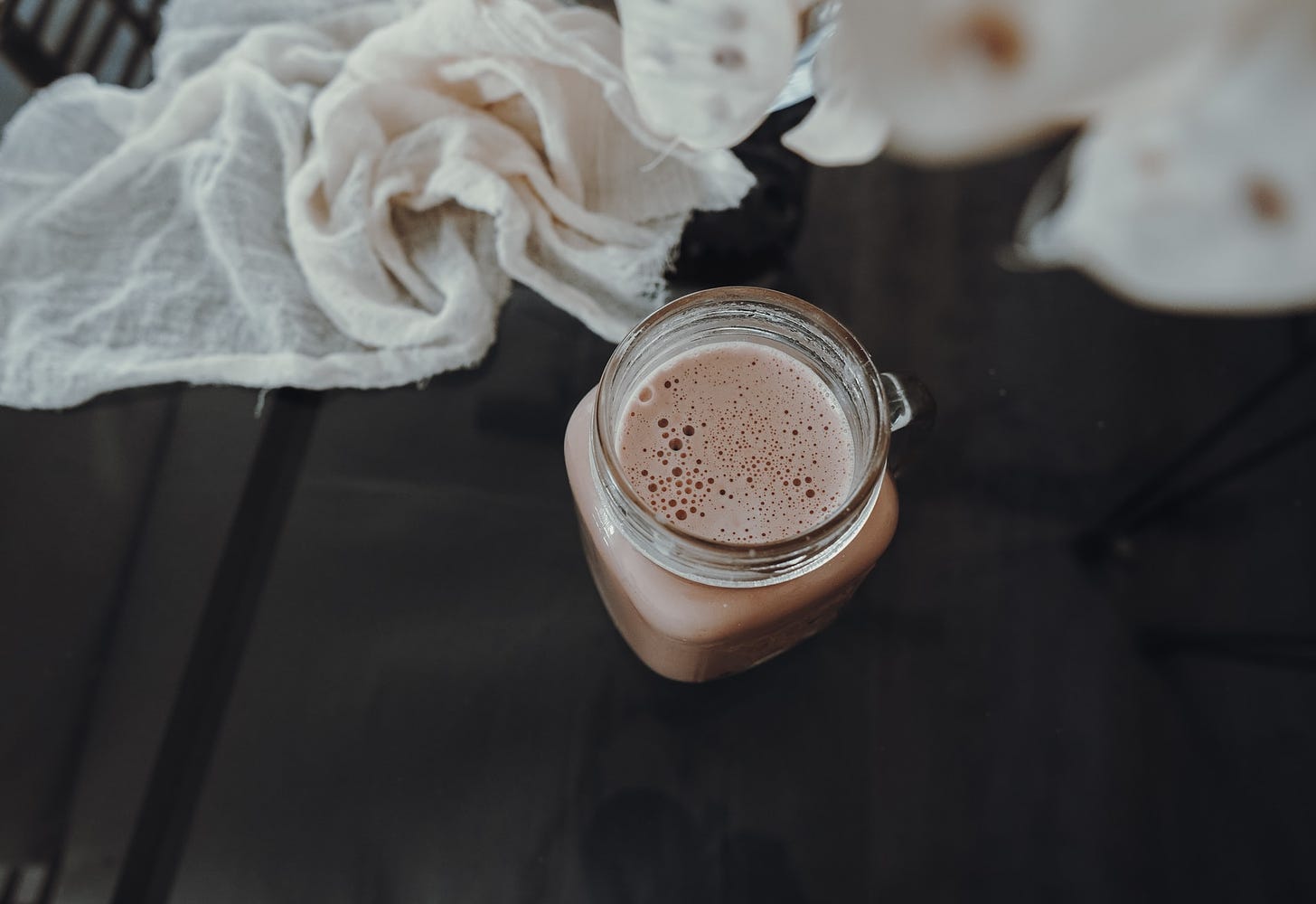Reclaiming Diet Coke
If you remove the intention to diet from your diet foods, what you have left is...food.
Q: I enjoy a lot of diet foods after being raised on them. Should I hide them from my kid or not share? I feel like I’m trying to make a statement that’s damaging either way.
There are two “diet foods” that remain in my life, more than six years after my last diet.
The first is Diet Coke. I’m drinking one as I write this piece. It is the diet food (well, beverage) that I was raised on. My grandfather was a pharmacist who ran a wholesale drug company and he believed in the curative powers of a flat Coke for every ailment. A proto-wellness influencer, if you will. So my dad and his brothers grew up drinking a lot of Coke. One favorite family legend is that they drank so much, the Coca-Cola truck made deliveries directly at their house before going on to the town grocery store. Another is that my dad somehow procured a used Coke vending machine that he took to college and set up in his dorm room to make a little extra cash. My point is that we are not a Pepsi family.

But by the time I was growing up in the 1980s, my dad (and a lot of my other relatives) had switched to Diet Coke because that was the heyday of low-fat/low-cal diet culture. So I was introduced to Diet Coke first, and by the time I tried regular Coke, my taste buds were programmed to prefer aspartame to sugar. My parents bought Diet Coke and caffeine-free Diet Coke (which, I’m sorry, just tastes like sadness). Another family legend that I witnessed with my own eyes more than once is that my younger sister drank Diet Coke in her baby bottle and my step-mom would say, “but only caffeine-free!” in an effort to still draw some kind of line in the parenting sand. To be fair, my sister was a pretty demanding toddler, but perhaps more reassuring/relevant to our broader theme here: Now, as an adult human, she does not like Diet Coke and mostly drinks seltzer. Remember how I always tell you that kids will habituate and you don’t need to restrict food? She is proof. (She did have a lot of cavities in her baby teeth though, so maybe stick with milk and water in your baby bottles. Also! She’s getting married this weekend, does this baby bottle story make it into my toast?)
To be honest, I often forget that Diet Coke is a diet food, even though it’s right there in the name. I never drank it to lose weight; I have always only drunk it because I like the taste. I don’t give it to my children because I only buy the kind with caffeine, but I won’t ban them from drinking it when they’re old enough not to bug me when they stay up too late.
The second diet food in my life is a true diet holdover. In 2015, I wrote a story for Self called “Can You Really Detox?” Oh man, all the trigger warnings on that link because it is a TOUGH READ now. At the time, I would have told you I was doing an investigation on why detoxing is bullshit. And I did a little of that, and then I did a lot more of that when I wrote about detox culture in my first book. But my editor also persuaded me to go on a 21-day detox in the name of journalism and it is very clear from reading the final draft that I didn’t actually need that much persuading and I was much more immersed in my old diet mindset than I realized. We should also keep in mind that this was Self before it went digital-only, got radicalized, and started publishing folks like Aubrey Gordon and Jessica Jones, so I think there is a first draft somewhere in my files that was harder hitting, which then got the standard lady mag treatment. But also: I was on a diet and telling myself it wasn’t a diet and writing about it and the result is a hot mess.
Anyway, that detox is where I learned about chocolate protein powder.
The doctor who put me on the detox prescribed her custom protein powder for the morning smoothies she taught me to make. After I finished the detox, I realized that her $60 protein powder was pretty much identical to the (also over-priced!) $20 jar I could buy at Wal-Mart. Six years later, I still have a smoothie made with milk, frozen blueberries, peanut butter, and chocolate protein powder every morning. I love it so much. I wake up excited to make it. When we travel, if we’re staying somewhere with a blender, I pack those ingredients. And yes, I make it for my kids, too.
And I have thought a lot about whether this smoothie — which, yes, 100 percent, is the most cliched example of modern diet culture — is a diet culture holdover for me, and the answer is: Nope. I do not drink it with any expectation of weight loss. I don’t know how many calories are in it; I don’t measure ingredients (other than to consider flavor balance) and I don’t think about portion sizes. I also don’t expect it to keep me full for some insane amount of time; I drink it around 6:00am and by 9am, I am once again starving and eat a second breakfast. The smoothie is a useful, convenient and delicious way to ensure I eat something substantial in the first hours of my day which can otherwise be quite chaotic in a house with young children. And that’s all.
I make myself the same exact smoothie every day because I am 40 years old and I know what I like (and it’s never going to be kale or acai or trying new foods first thing in the morning). With my kids, I mix it up a little more and use smoothies to offer different flavors or foods they aren’t otherwise eating too often. I’m also transparent about what goes into their smoothies; I don’t sneak ingredients and I don’t use them to pack in 14 kinds of produce because nobody likes to drink brown sludge. (I’m a fan of Yummy Toddler Food’s recipes and advice on this matter.) But I do add chocolate protein powder every day in the case of one child who only likes smoothies if they are chocolate-flavored, and a few times a week in the case of the other child, who will happily eat a wider variety of smoothie flavors.
There is no diet intention behind giving my kids smoothies with protein powder. I never force them to finish them, nor do I serve smoothies in place of other foods. I’ll admit that they do give me some reassurance that they are eating enough to still grow during those “dinner is two bites of pasta and some carpet lint” phases. But that’s an emotional, not scientific, response. I trust my kids to eat what they need even on days they aren’t eating much. You don’t have to give your kids smoothies if they don’t like them, and you certainly don’t have to add protein powder.
But you also don’t have to hide your protein powder, or your Snackwells, or whatever other diet food you grew up with and still genuinely like. “Our bodies have no judgment about where food comes from,” says Anna Sweeney, RD, a social-justice oriented disabled dietitian who will be my guest on Thursday’s audio newsletter. She said that when we were talking about pasta (so tune in if that has ever been a fear food for you), but it’s true of literally all food. Your brain has to sort through the marketing hype and conflicting emotions that certain foods bring up—but your stomach just has to digest it. And if our goal is an anti-diet house, then that means no foods are hidden, forbidden, or otherwise off-limits (unless it’s a particular treat you want for your own secret comfort food eating ritual, as I explained here). Even more important: An anti-diet house means we do not serve foods with diet intentions. We’re not replacing one food with a less indulgent version; we’re not banning foods; and we’re not expecting or hoping that how we eat will make us smaller.
If you have removed the dieting intentions from your diet foods, all you have left is...food. So enjoy it! And when your kids learn to read labels, call out the diet culture you see on them. Tell your own family food myths; own what you once thought this food would do for you and why that’s silly, and then talk about why you still like it. They may surprise you and not particularly like your comfort-diet-foods themselves, because they are not dieting and therefore can recognize that full fat cookies taste better than the lite kind. But don’t let them steal your joy—just make sure you’re giving yourself the same full permission to eat.
ALSO
Coming up: As mentioned above, the audio newsletter this Thursday is an interview with Anna Sweeney, whom you may know as @dietitiananna. Anna and I talk about Noom, reclaim pasta, and answer a few reader questions. Subscribe now so you don’t miss it! And check out Anna’s amazing Virtual Connection videos on Insta; they are a great resource if you are working through disordered eating issues and need some extra support.
Talking “snackaholics:” Are kids asking for snacks because they’re hungry, or are they just trying to drive you crazy? My friend Melinda Wenner Moyer is asked that very question in a recent issue of her excellent newsletter, Is My Kid The Asshole? (And Yours Truly is among the experts called upon to help answer.) Read her tips and tricks for dealing with snack time here, and for more science-based strategies for raising your kids, pre-order her book, How To Raise Kids Who Aren’t Assholes.






I know you said you don’t measure out ingredients, but… Can we get an approximate recipe for that smoothie? 👀🙏🏻